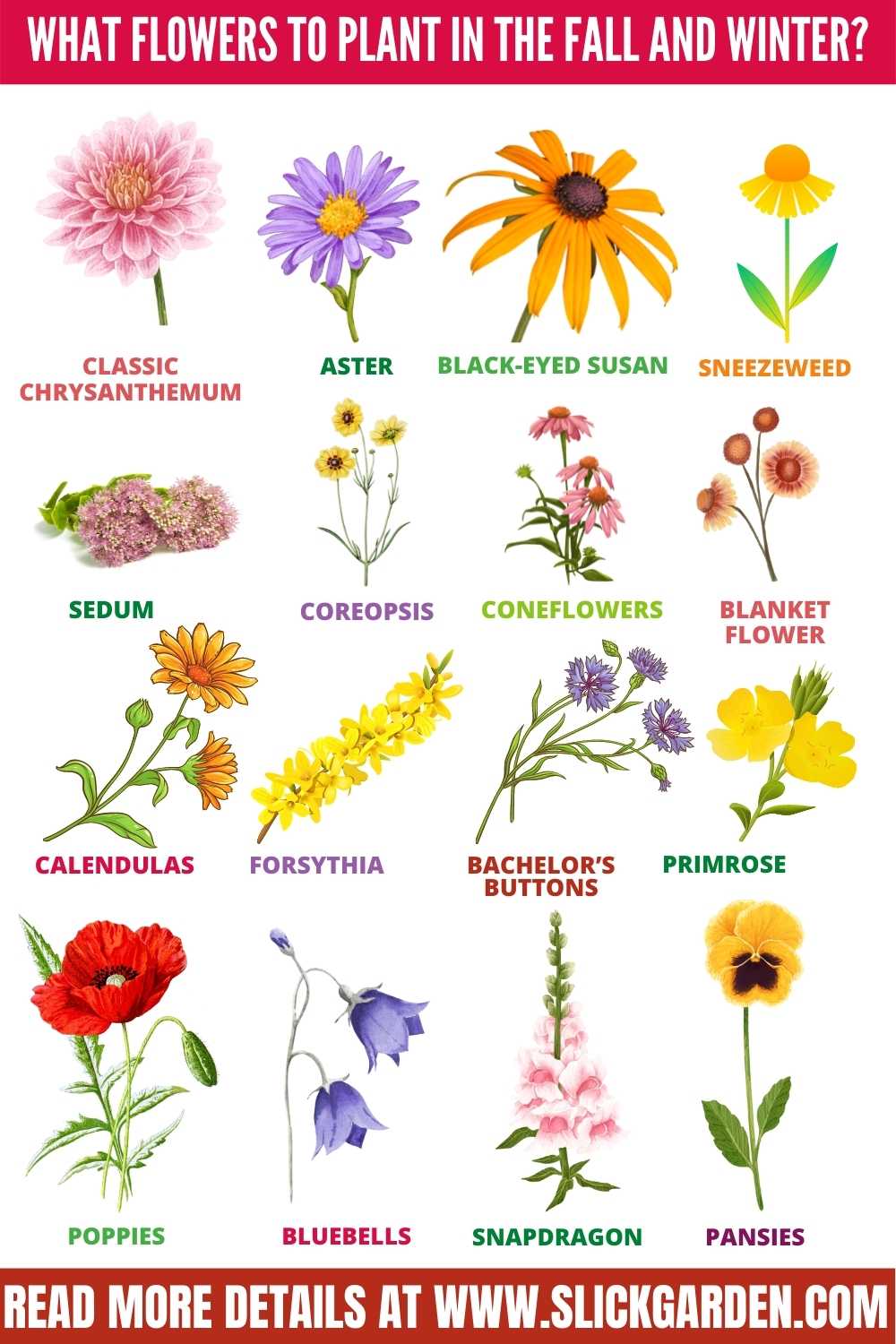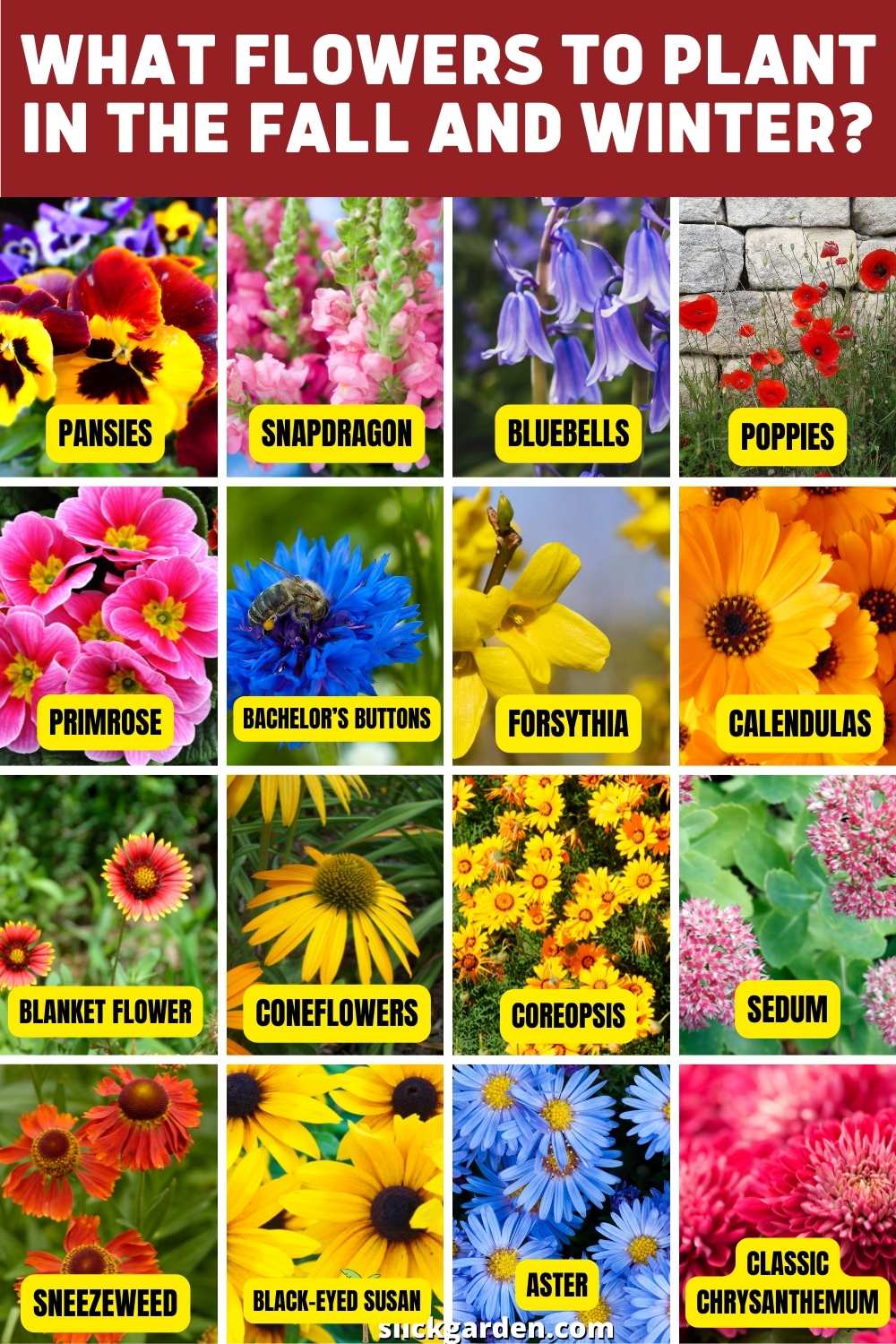Spring is the best time to plant flowers and add colors to your garden. But you should not limit this joy to spring and summer; you can plant flowers in fall and winter. When September comes out the gardeners feel tired. They should not do this and never mitigate their enthusiasm.
You can plant fall-blooming annuals and perennials. If in your area, frost comes early then annual may have a short life. But in the case of perennials, they may produce fewer flowers at first but in future years they will be high producers.
What Flowers To Plant In the Fall?

The plants that are in the following waste Bloom only in fall.
1- CLASSIC CHRYSANTHEMUM
Chrysanthemum comes in different colors such as orange, yellow, and red. The shapes of the flowers are also different for different varieties; some flowers have quill-like petals, some have daisy shapes and some look just pom.
The mature size of the plant can be four to five feet. The best time of planting blooming varieties of chrysanthemums is in the fall before the first frost.
Make sure you are using well-drained and rich soil. When winter comes, chrysanthemums stop producing flowers, at that time, you have to cover them with mulch. For mulching, you can use sawdust and sand.
2- ASTER
Aster comes in purple, blue, and pink flowers with a yellow center. These warm colors look amazing in the autumn season. Aster comes in a wide range of colors.
This plant needs full sun to produce beautiful blooms. You must use the best fertile soil for growing this attractive plant. If you are planting aster in pots then you must use a pot that has drainage holes at the bottom.
If you have chosen a taller variety then it needs staking. You should divide this plant before it becomes so invasive or woody. Make sure your plant gets water on time. You have to maintain a frequency of water.
3- BLACK-EYED SUSAN
You must decorate your fall garden with this glorious plant. butterflies, bees, and even birds are attracted to this plant. Susan plants need little maintenance so if you are a beginner you can easily deal with them.
Mostly this plant blooms in summer but the blooming season can be extended to fall. The frequency of the water should be moderate to regular with full sunlight. This plant can also tolerate light shade.
The maximum height of this plant is from 2 to 10 feet, for pots you can choose smaller varieties. Also, the best time for planting Susan is in spring but they also give colors in your autumn garden. If you choose a tall variety then stake them.
4- SNEEZEWEED
Sneezeweed attracts butterflies due to its exquisite and gorgeous colors of bloom. Bright yellow to brownish flowers will add colors to your landscape in autumn.
The mature size of the sneezeweed plants is 3 to 5 feet. Your plant will thrive well if it gets full sun and regular water. For taller plants, you should stake them so they will get proper support.
5- SEDUM
The best-known sedum is Autumn Joy. As the name shows that this plant belongs to the fall garden. This plant needs little maintenance and easily adjusts in poor soil.
Make sure you are using well-drained soil because this plant doesn’t like wet feet. Avoid over-watering because it is another hindrance to the growth of your plant.
When your sedum plant is established then it can tolerate drought. The mature size of the plant is from 9 inches to 3 feet. The height of the plant depends upon the variety and conditions. Full sun is best for this plant but partial shade is also tolerable.
6- COREOPSIS
The other name of this plant is twickweed. It needs little maintenance and its flowers come in different colors such as yellow, red, orange, and purple. It can adjust in any type of soil but it must be well-drained.
If you want your plants to thrive well then you should use well-drained soil because standing water is not good for the health of your plant. When your plant is established you can reduce the frequency of water during the growing period.
Avoid over-watering to prevent your plant from root rot and many fungal diseases. Full sun is good for coreopsis plants. The mature size of this plant is from 1foot to 2 ½ feet. Ask this blonde to spread very quickly so you have to divide it after every few years.
7- CONEFLOWERS
The botanical name of the coneflower is Echinacea purpurea. This hardy perennial plant has a long blooming period. The purple coneflower is very popular and attracts butterflies, bees, and other birds.
Full sun and regular water develop your plant. This plant can tolerate drought. Deadhead will encourage the growth of new blooms. The mature size of this plant is from 2 to 4 feet.
8- BLANKET FLOWER
If you are looking for a long-blooming perennial plant then the blanket flower is the right choice for you. The flowers of this plant start blooming from early summer to fall. Red, orange, yellow, and maroon flowers attract bees, butterflies, and birds.
Blanket flowers can tolerate frost and wind. You must choose a sunny location for this plant so it will get full sun exposure. Make sure you are using well-drained soil.
To improve the quality of this soil you can amend it by adding organic materials. This flowering plant can easily grow from seeds. If this plant becomes crowded then you should divide it for further growth.
Keep Reading:
- Best Annuals Flowers For Raised Beds
- Flowering Plants For Very Small Pots
- 20 Shade-Loving Flowering Plants
What Flowers To Plant In The Winter?

Mild winter or desert climatic areas are better for planting search plants that can continue blooming throughout the winter. This is good news for the people who live in the warmer corners of the world.
They can even plant in December and January. Gardeners who live in a colder climate should not lose their hearts because they can also plant winter indoors. When their area’s last frost passes they can bring their plant outside.
Here is a list of flowers you can easily plant in the winter.
1- CALENDULAS
The colors of this flower can be seen from fall to spring in mild winter areas. The different colors of flowers of this plant are found in classic orange with a yellow center, apricot, soft yellow, and cream.
This plant grows 2 to 3 feet tall and 1 to 1-½ foot wide. If you choose this plant then it will make your garden more colorful. You should select a sunny location for this plant so it will produce beautiful flowers. Well-drained soil and moderate water are perfect for its growth.
2- FORSYTHIA
The other name of this flowering plant is yellow bells because of the color and shape of its blooms. February is the best time for planting for Forsythia.
The location of this plant is very important because 6 hours of Sunlight is essential for the growth of the flower. For growing this beautiful flowering plant, you must use well-drained and loose soil.
When your plant is established you should maintain the frequency of water. In the time period of drought, you have to increase the amount of water for this plant. You can apply fertilizer after one year of planting.
3- BACHELOR’S BUTTONS
The other name of this flowering plant is cornflowers or blue bottles. The color of the cute wildflowers is bright blue. In the past, the flowers of this plant were used for placing in a button hole of a shirt or suit before meeting his lover.
That’s why its name is bachelor’s buttons. You can plant these attractive flowers at the end of the winter. The blue flowers start blooming in early summer.
Make sure bachelor’s buttons grow in well-drained soil and receive full sun exposure. This flowering plant is drought tolerant but you water it regularly.
4- PRIMROSE
Most species of primrose bloom in spring or early summer. Besides these species, some types bloom in winter. Most of the species can grow as cold-season annuals.
English Primrose starts blooming from winter to spring. The beautiful and attractive five-petaled flowers have romantic clusters. The bright and showy flowers can easily be grown in the pots.
A cool and humid climate is required for the development of beautiful Primrose plants. Make sure you are using moist and rich soil for its growth. You can also choose a partially shaded location for this plant. You should maintain the frequency of water and apply half-strength fertilizer for feeding.
5- POPPIES
Poppies like to grow in cold climates. They can’t tolerate heat so you can easily sow the seeds outdoors in the fall or winter. The presence of poppies will brighten up your growing area.
For beautiful blooms, you should select a Sunny location for this plant. Regular water with well-drained soil is also helpful in making your garden more colorful. When poppy plants are established then you can feed them lightly.
6- BLUEBELLS
Bluebells can decorate the winter garden with their dreamy colors. Bluebells like to grow in moist and well-drained soil. Partial shade is good for them but they can tolerate some sunlight.
It is better to plant them beneath trees so they will get dappled shade. You can easily grow bluebells from seeds. The seeds of bluebells need cold weather for their germination.
7- SNAPDRAGON
Another beautiful flower that is included in our list is Snapdragon. Snapdragons are found in a variety of colors such as yellow, red, burgundy, pink, orange, bronze, white and multicolored.
It is a cold hardy plant and it can withstand sub-freezing temperatures. During the winter season, you should water this plant well and it is suggested that you should use a layer of pine straw mulch.
Mulch helps to retain water in the soil. After the cold season, you can apply to dilute water soluble 20-20-20 fertilizer.
8- PANSIES
The best time for planting is during September and early October. During the pre-winter period, this plant grows sturdy roots and produces more flowers in winter.
Your flower beds, borders, hanging baskets, and pots become colorful after adding winter pansies. To make your soil more reach you can use multipurpose compost.
Four continue blooming throughout the growing season; you should feed the plant regularly. Although pansies are short-term perennial plants, if you care for them properly then they can last 3 to more years.
During prolonged cold periods, you should protect your pansy plants by covering them with horticultural fleece. The covered pansies must get regular water because covered areas can also dry out.
You should keep your soil moist by regular watering. The best way of checking the moisture level of the soil is by placing your finger in the soil. If you feel the soil is dry then this is the best time to water your plant.
If you are growing pansy plants in the pot then make sure the pot you are using must have drainage holes. Drainage is very important to protect your plant from root rot and many fungal diseases.
